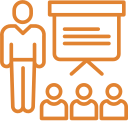Spot Unmet Customer Needs with Design Thinking
There are several ways you can go about becoming more customer-focused, and design thinking is one of them.
Design thinking is a human-centered approach to innovation used by some of the world’s leading companies, such as Google, Procter & Gamble, Apple, and more.
When organizations develop human-centered design capabilities, they become better able to really understand their customers to become more customer-focused. They learn to ask different questions, listen more closely to the answers, and identify unmet needs they can then fulfill.
Many businesses around the world use design thinking and have seen fantastic results. In fact, between 2005-2015, design-led, publicly-traded companies outperformed the S&P Index by 211%.
But in some cases, organizations’ attempts to adopt design thinking don’t work out. This tends to be because although individuals may have attended training or engaged with design theory, they haven’t been through enough cycles of practice to metabolize it and become able to use it to create real change.
For Design Thinking to Become Part of Your DNA, You Need the Chance to Practice It with Support
Design thinking isn’t something you can go and learn in a classroom and then go back to the office and apply successfully by yourself. It’s a fundamental mindset shift, so practice has to be part of the learning process.
Becoming a designer is transformative. It requires you to set aside every assumption you have about your customers, your business, and what brings about success and be open to something completely new. By taking up design thinking, you are volunteering to purposely step into the unknown and discover what your customers really want, which may not only be different from what you’re currently offering but also completely outside of what you believe is possible.
Practice Removes the Fear and Helps Everyone Explore the Opportunities Design Thinking Opens Up
To help you and your organization get comfortable with design thinking and how it works, you need the opportunity to put theory into practice with support.
The most effective way to develop lasting design capabilities is to tackle a real challenge your business is facing using design thinking with assistance either in-person or online.
Going through several cycles of practice in the safety of an ongoing learning environment helps people who are new to design get comfortable with it and reduce the inevitable fear of failure that comes with trying out a new way of working. Doing this also gives others in the business the chance to have exposure to what design looks and feels like so that they can get on board with it, too.
Storytelling Demonstrates the Difference Design Thinking Makes to Your Customers and Your Growth
However big or small the wins that design capabilities help you bring about, it’s vital that you keep reporting them back to your team. There’s no better way to get your colleagues and leadership on board with a new approach than by showcasing the benefits it’s bringing.
When you’re able to demonstrate how the business is shifting to more intuitively meet people’s needs – and the financial gains that are achieved – everybody will want to be part of the journey that makes that happen.
Treehouse Innovation helps leading private, public, and not-for-profit organizations around the world to develop innovative new products, services, and strategies, build internal innovation capability, and transform their culture. We’re also the team behind Sprintbase, the online platform built by seasoned designers to help people – regardless of background or prior experience – accurately, consistently, and repeatedly apply design thinking to the challenges they face. Want to find out more about how you can use design thinking to become a more customer-focused organization? Get in touch.

















